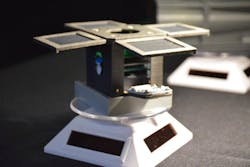Mini-Cubes, LLC (Akron, PA) started a project based on the engineering of a constellation of PocketQube satellites for monitoring a specific Earth resource—water. The company turned to CRP USA (Mooresville, NC) for the manufacture of the entire satellite frame using Windform TOP-LINE composite materials for laser sintering, created by CRP Technology (Modena, Italy).
The main challenges were related to the small dimension of the PocketQube satellite and the material, since it was the first time that an entire satellite would be built from a carbon-composite material. These spacecraft are amongst the smallest, with 50 × 50 × 50 mm internal volume.
“Discovery, our particular satellite, is a demonstration of what can be done for remote sensing of Earth’s resources on that scale. The challenge with something so small, is to fit the electronics, camera, and radio system into it,” says Joe Latrell, CEO of Mini-Cubes. “The assignment was tough—the Windform parts in the Discovery would be mission-critical.”
As Latrell clarifies, “This was the first time an entire satellite would be manufactured from a material like Windform XT 2.0. Performance is everything. If any one of the parts fail, it would result in complete failure of the spacecraft.”
CRP USA manufactured three 1P PocketQube functional prototypes: two for testing and one for flight. “We have run quite a few tests with many more on the way,” Latrell comments. “So far, we have load tested to over 20 Kg. The material has been vibration-tested to NASA GEVS-7000 specifications, subjected to a near vacuum to simulate the conditions in Earth orbit, and thermally tested from +50° to -40°C. Windform XT 2.0 has passed every test we threw at it. The next step for us is to test the satellite on orbit. This will be the final validation for our process. The plan is to launch sometime in Q2 2021.”
For more information, please visit mini-cubes.com and crp-usa.net.
